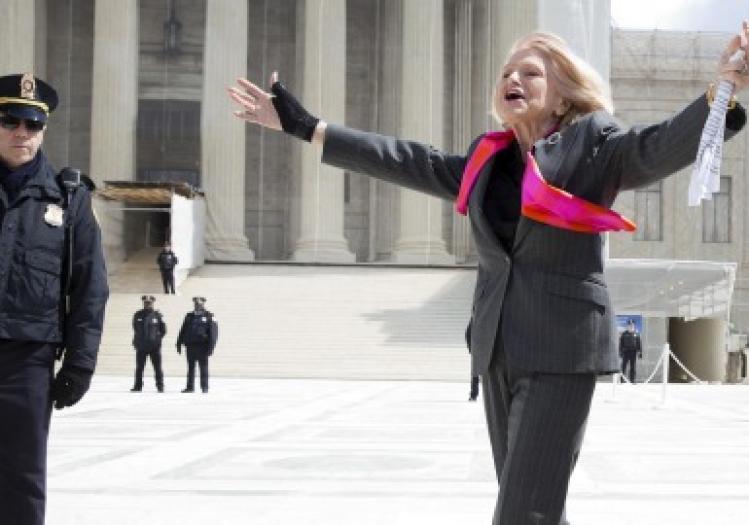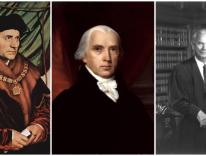
There have been few changes in our moral, sexual, and legal culture more precipitous or, in some ways, more dramatic than the normalization of homosexuality and the growing acceptance of same-sex marriage. Within the lifetime of many Americans, homosexuality has gone from being a universally condemned vice, often only whispered about, to being an accepted and often celebrated sexual preference or identity. These attitudinal changes are especially pronounced between the generations, with younger Americans broadly supportive of the political demands of their gay and lesbian friends while their parents and grandparents continue to find these developments disorienting if not threatening to once-unquestioned values underpinning the family and traditional gender roles.
Commonweal has expressed skepticism and urged caution regarding the legalization of same-sex marriage, while at the same time defending the rights and dignity of homosexual persons both in society and in the church. In the aftermath of the chaos and destruction, both personal and social, wrought by the so-called sexual revolution, the rush to change the fundamental heterosexual basis of marriage seemed imprudent. With the institution of marriage already in crisis, such an unprecedented social experiment appeared to pose risks—especially to the already precarious place of children within modern marriage—that were all but impossible to measure. With divorce and out-of-wedlock birthrates soaring, tampering with the inherited understanding of marriage seemed like only one more instance of “enlightened” hubris. Advocates cast same-sex marriage as the extension of basic rights to a once excluded group, but it is likely also a reflection of—and a further step toward—an essentially privatized and libertarian moral culture.
None of these worries has been assuaged in any definitive way. There is simply not yet enough social-scientific data to say one way or the other how children raised in same-sex marriages fare, although there is plenty of anecdotal evidence suggesting that same-sex couples are as devoted to their children as their heterosexual neighbors. Will severing the connection marriage has historically forged between sex, procreation, and family formation further undermine the expectations and value our culture places on the institution? No one knows the answer to that question either, but it seems we are about to find out. Clearly, the societal consensus about what it means to treat heterosexuals and homosexuals equally has changed, and it comes as little surprise that the Supreme Court has followed that new consensus by removing recently erected impediments to same-sex marriage.
In United States v. Windsor, the Court ruled that in defining marriage as between one man and one woman the Defense of Marriage Act violated the “equal liberty” rights of same-sex couples. In Hollingsworth v. Perry, the Court let stand a lower court’s decision to strike down California’s Proposition 8, which prohibited same-sex marriage. For the time being, other state laws restricting marriage to heterosexual couples will stay on the books, but the DOMA ruling makes it unlikely those laws will survive legal challenges, which are already being brought in several states.
Ideally, divisive moral and social questions on which the Constitution is ostensibly silent are best left to democratic deliberation in the states, where those on the losing end of the argument would at least have the consolation of knowing that their views got a hearing from their fellow citizens. Those pressing for “marriage equality,” however, are not likely to leave the question up to majority vote. Most of the cultural and legal momentum now clearly favors same-sex marriage, and in truth it is hard not to be moved by the evident joy of same-sex couples over the Court’s decisions. At the same time, Americans who oppose these developments, most of whom do so for religious reasons, have cause for concern.
In the DOMA decision, Justice Anthony Kennedy characterized Congress’s effort to limit marriage to heterosexual couples as a “desire to harm,” dismissing the reasonable if speculative concerns of many Americans as mere bigotry (see "Worth Worrying About?" and "Right Decision, Wrong Reason"). Kennedy’s indictment is shortsighted, and exposes those with serious reservations about the emerging consensus to possible legal action for violating antidiscrimination laws. As Commonweal has editorialized in the past (“Protecting Religious Freedom”), champions of equal rights should support the broadest possible protections for dissenting religious communities and their associated agencies. It is one thing for the courts to rule that there is no constitutional justification for denying civil marriage to same-sex couples; it is quite another thing for the courts to force religious institutions to recognize such marriages in their employment and benefits agreements. Under our constitutional system, the state must give the widest possible berth to religious practice, and it is imperative that dissenting religious communities not be driven from the public square over this issue. As many of the most eloquent proponents of same-sex marriage acknowledge, Americans will need time to adjust to this change. Traditional religious communities continue to do indispensable work in caring for the needy, educating the young, and calling the larger society to account on important questions like war, torture, abortion, euthanasia, and economic justice. American democracy cannot afford to deprive itself of those moral and social resources, yet that is what could happen if the law comes to equate institutional resistance to the recognition of same-sex marriage with racial discrimination.
In this regard, it is no secret that the United States Conference of Catholic Bishops has been among the most outspoken opponents of same-sex marriage. The conference’s advocacy, which has often cast the debate in hyperbolic terms, has persuaded few and offended many. With typical alarm, the bishops’ Subcommittee for the Promotion and Defense of Marriage issued a statement calling the Court’s decisions “a tragic day for marriage and our nation,” and a “profound injustice to the American people.” The statement went on to use variations on the phrase “the truth of marriage” seven times in two brief paragraphs, as though mere incantation were a substitute for persuasion. A more dexterous rhetorical strategy is needed if the church’s witness to the “truth” about marriage is not to be written off as blind prejudice. The bishops might begin by emphasizing that the church strongly defends the dignity of same-sex oriented people, a fact most Americans remain ignorant of. The bishops might also acknowledge the good of faithful, life-long same-sex unions, as well as the progress made in the public recognition of the manifold achievements and contributions of gays and lesbians. It is also time for the church to open its eyes to the selfless work same-sex couples do in raising children, many of whom would otherwise go uncared for and unloved.
Surely, whatever its legitimate reservations about the legalization of same-sex marriage, it is time for the church to begin to come to terms with this challenging new cultural and pastoral reality, a reality that calls for far more than overwrought predictions of moral decline and social calamity. Same-sex marriage may prove to be a mistake or a failed and eventually abandoned experiment, but it is not an existential threat to the church or to Western Civilization. It is now time to listen and learn from those the church has long silenced or ignored. Who knows, those being listened to might even return the compliment.
Please email comments to [email protected] and join the conversation on our Facebook page.
Previous Story
'Belief Encourages Belief'
Next Story
An Act of Theology


